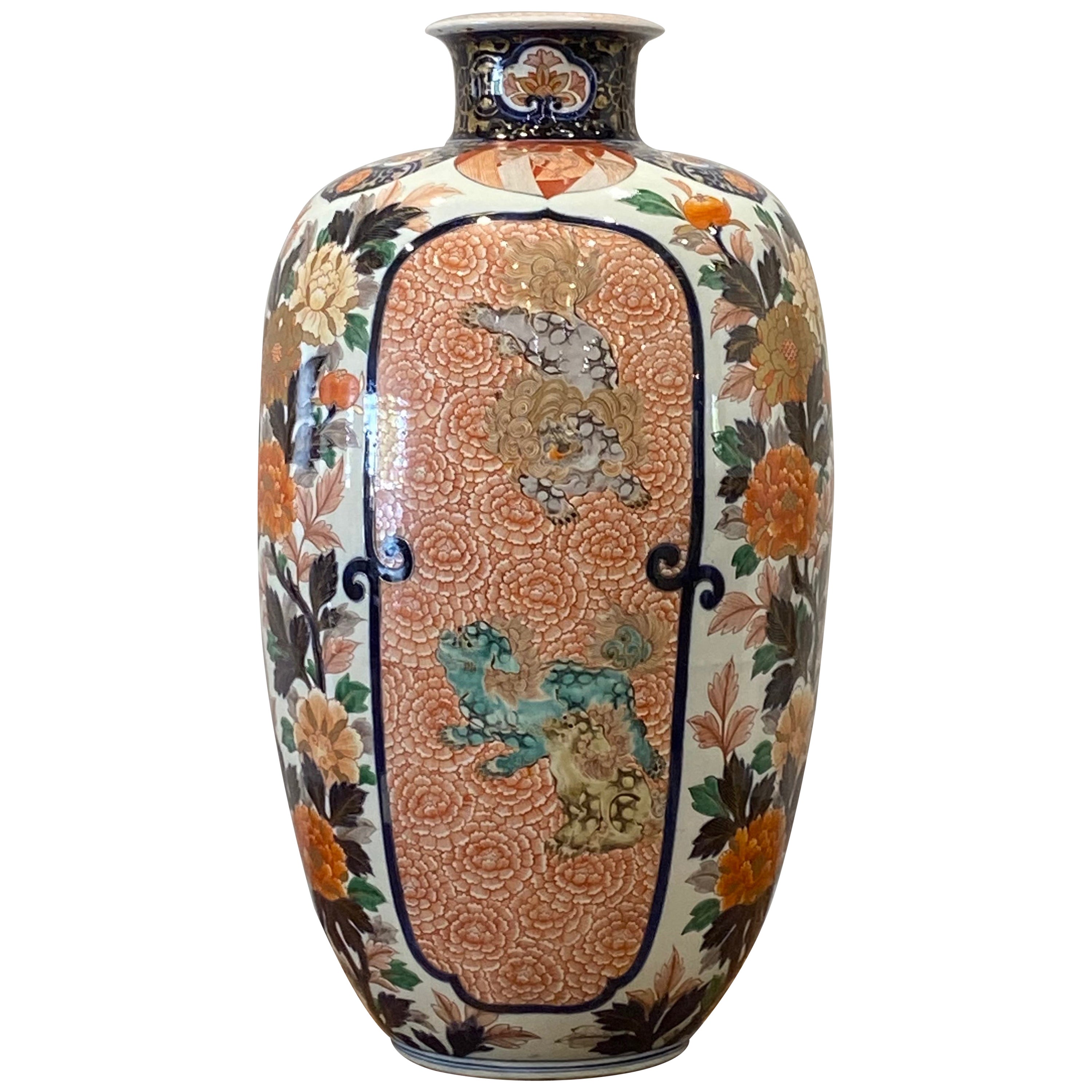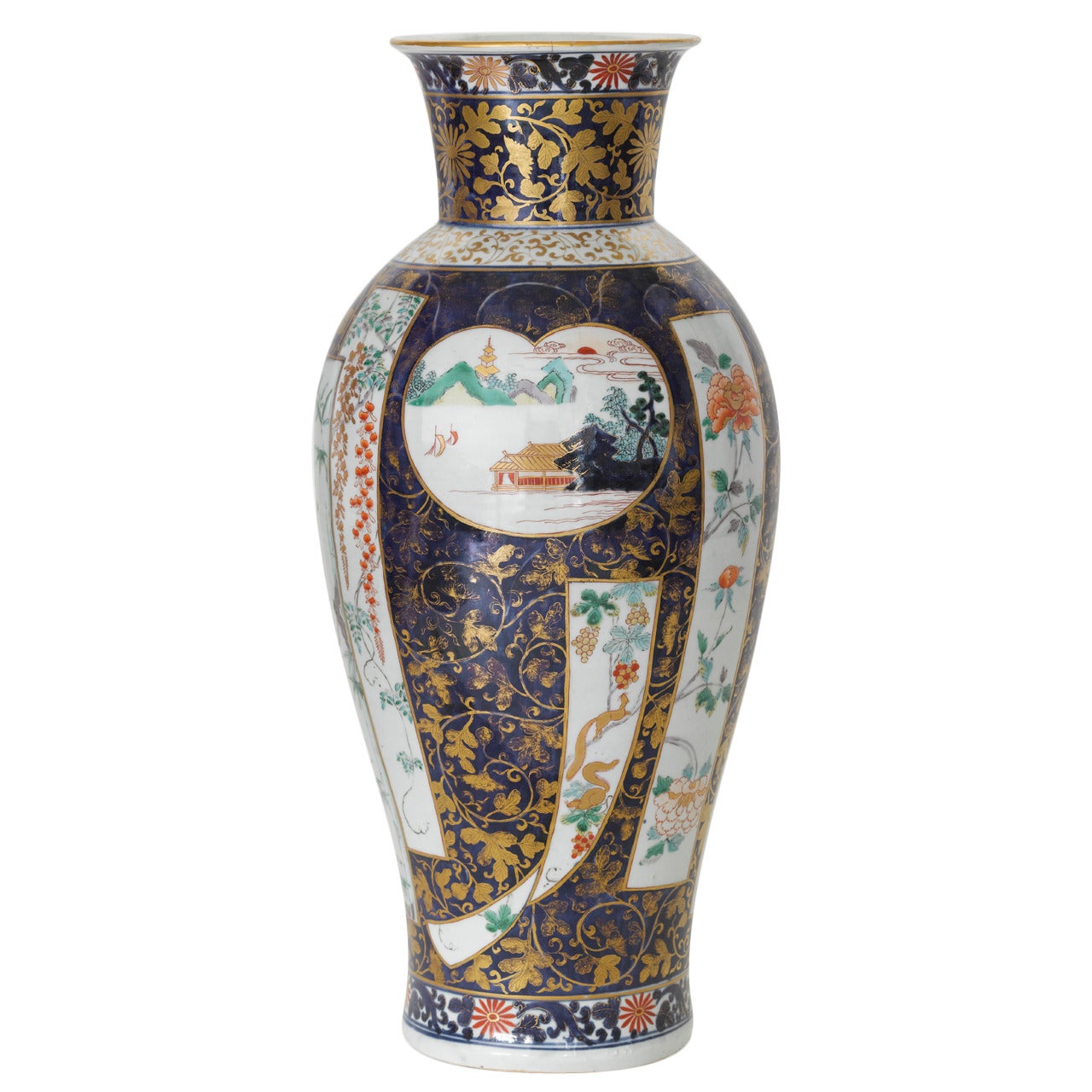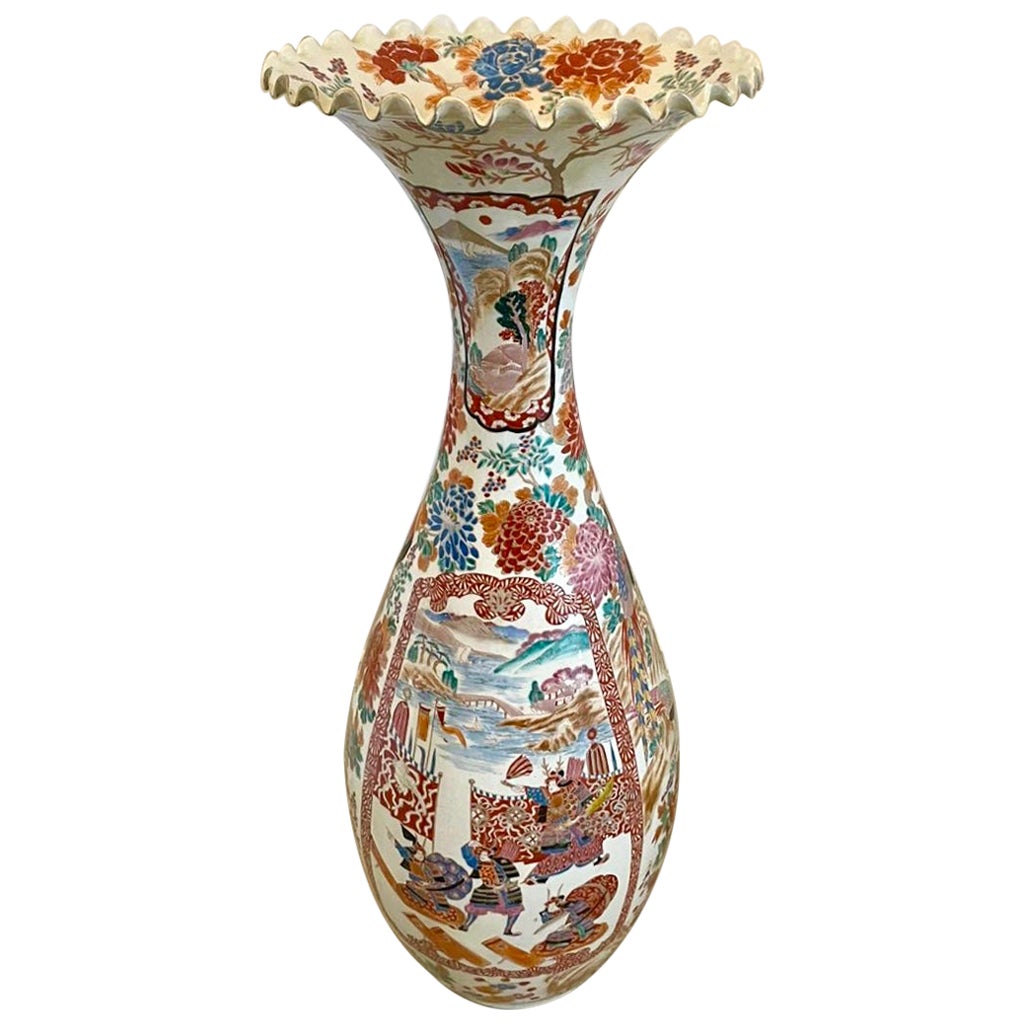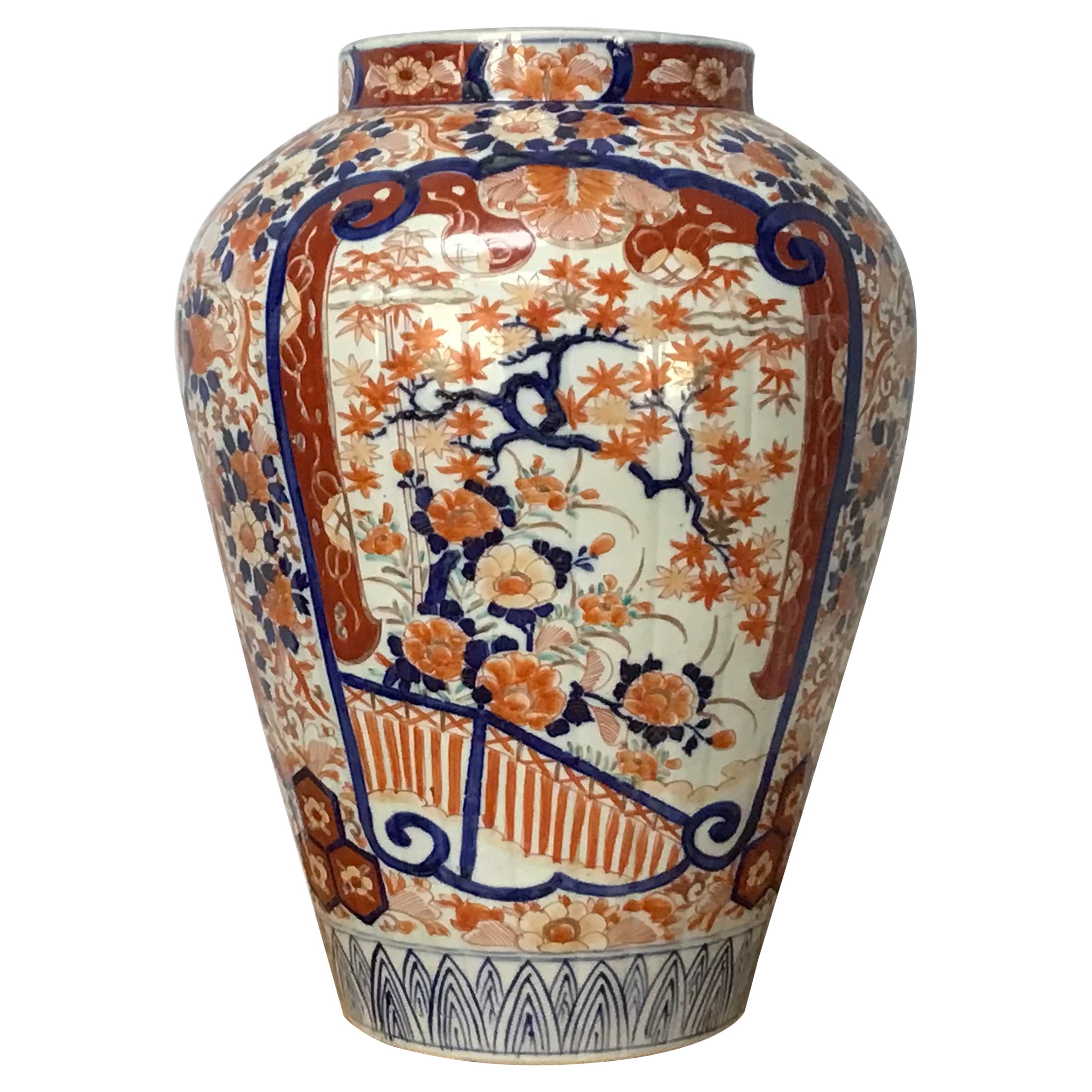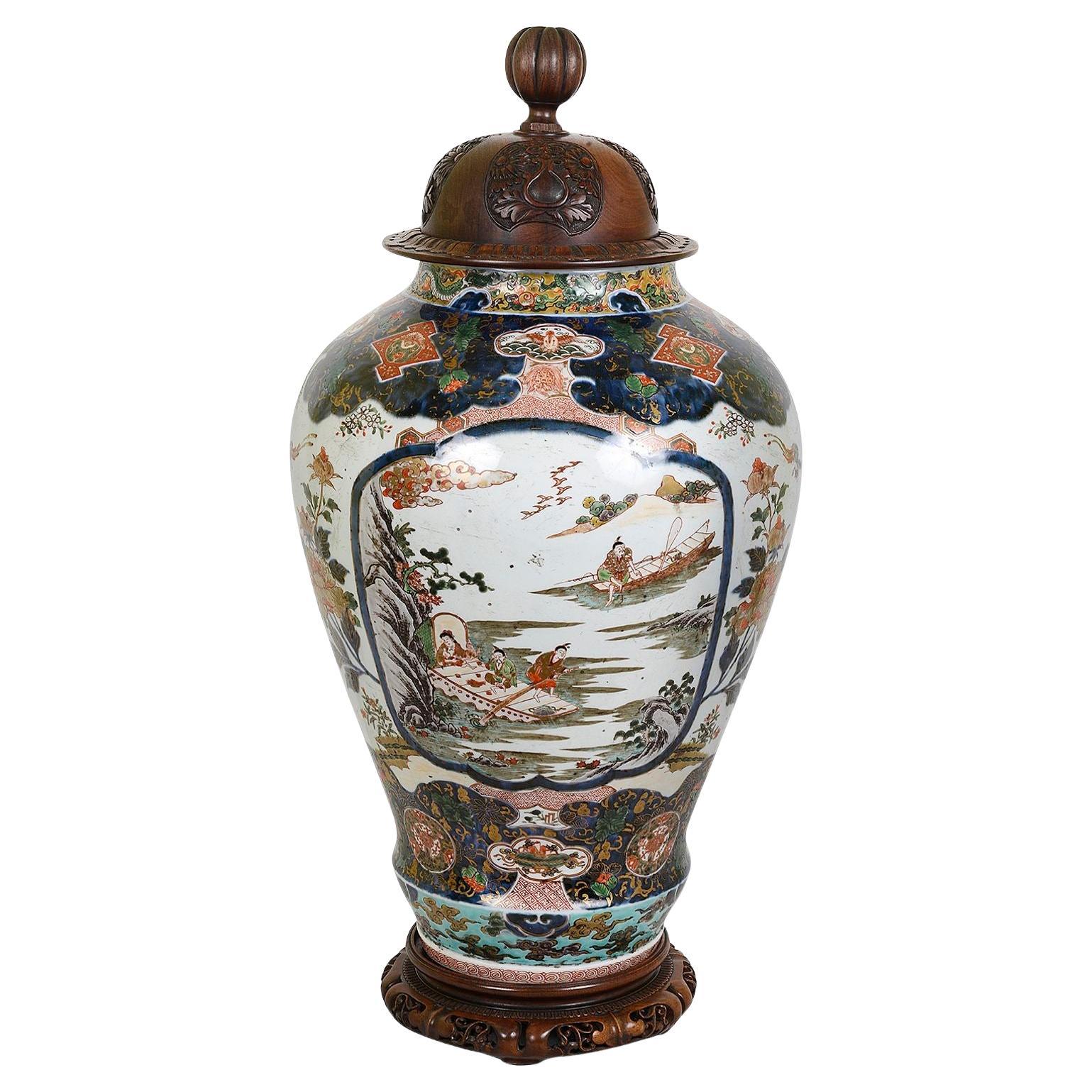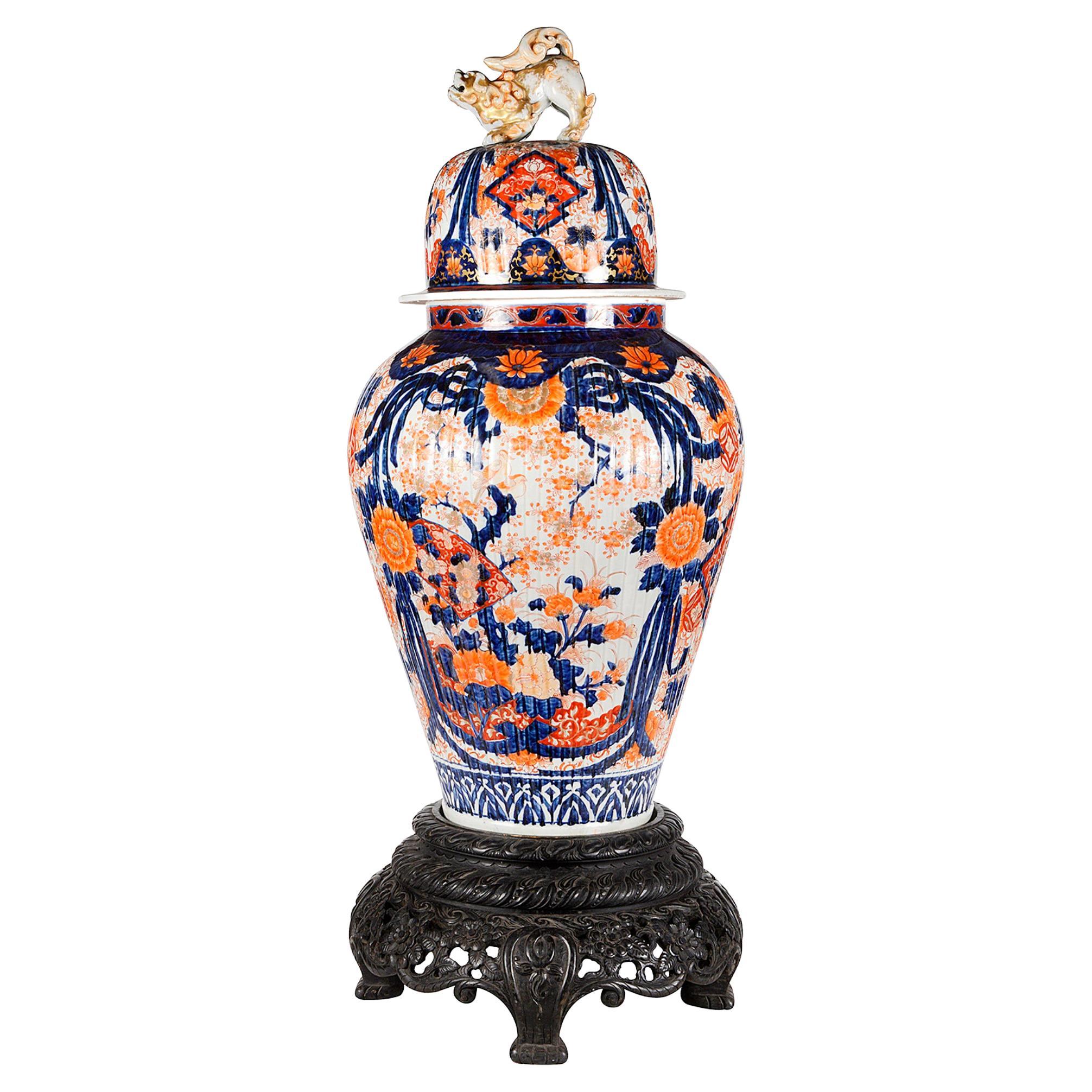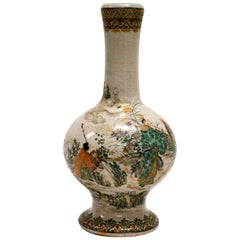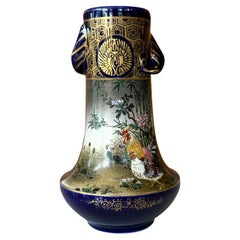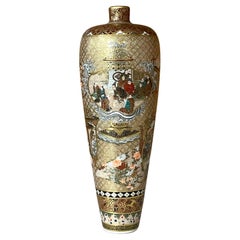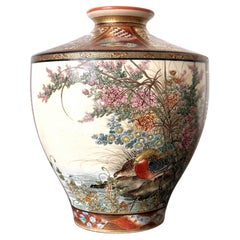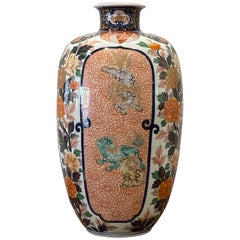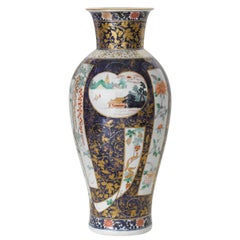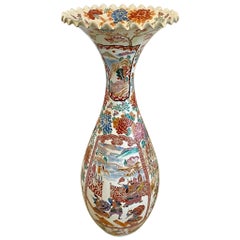Items Similar to Antique Japanese Imari Bottle Vase on Wood Stand
Want more images or videos?
Request additional images or videos from the seller
1 of 21
Antique Japanese Imari Bottle Vase on Wood Stand
$3,800
£2,883.35
€3,296.86
CA$5,307.57
A$5,901.30
CHF 3,081.33
MX$71,833.13
NOK 39,316.44
SEK 36,837.62
DKK 24,605.04
Shipping
Retrieving quote...The 1stDibs Promise:
Authenticity Guarantee,
Money-Back Guarantee,
24-Hour Cancellation
About the Item
On offer is a large Japanese Imari ceramic bottle vase with elaborate surface design circa 19th century (late Meiji Period). The distinct shape of the bottle is called tea-whisk form and the rare prototype was found in the early Ko-Imari production dated back to 16-17th century of Edo period. The shape was designed specifically to store liquor. This revived bottle was made in the 19th century and showcases decoration and colors typical of Imari ware. A lady in kimono holding a fan under a Sakura tree is showcased in the front and the back, with underglaze blue contrasting the rich overglaze enamel and gold. On the two sides, raised relief borders enclose scenes of combatant dragons and tigers under plum trees, both rendered in great relief details and of sculptural quality. The base was marked in underglaze blue the archaic Chinese characters "Da Ming Cheng Hua Year Made", which was typical for some Imari ware made during that time. It was historically drilled on the base and lower flank as a lamp base. The vase comes with a carved wood stand and measures 16.25: in height overall.
- Dimensions:Height: 12.6 in (32.01 cm)Diameter: 8 in (20.32 cm)
- Style:Meiji (Of the Period)
- Materials and Techniques:Ceramic,Glazed
- Place of Origin:
- Period:
- Date of Manufacture:19th Century
- Condition:Wear consistent with age and use. Minor losses. Mellow patina and overall glaze crazing and crackling lines, spotted stains from holding the liquor. Drilled on the base and lower flank as shown.
- Seller Location:Atlanta, GA
- Reference Number:1stDibs: LU945034342042
About the Seller
4.9
Platinum Seller
Premium sellers with a 4.7+ rating and 24-hour response times
Established in 2006
1stDibs seller since 2010
564 sales on 1stDibs
Typical response time: <1 hour
- ShippingRetrieving quote...Shipping from: Atlanta, GA
- Return Policy
Authenticity Guarantee
In the unlikely event there’s an issue with an item’s authenticity, contact us within 1 year for a full refund. DetailsMoney-Back Guarantee
If your item is not as described, is damaged in transit, or does not arrive, contact us within 7 days for a full refund. Details24-Hour Cancellation
You have a 24-hour grace period in which to reconsider your purchase, with no questions asked.Vetted Professional Sellers
Our world-class sellers must adhere to strict standards for service and quality, maintaining the integrity of our listings.Price-Match Guarantee
If you find that a seller listed the same item for a lower price elsewhere, we’ll match it.Trusted Global Delivery
Our best-in-class carrier network provides specialized shipping options worldwide, including custom delivery.More From This Seller
View AllEarly Japanese Satsuma Antique Vase
By Satsuma
Located in Atlanta, GA
An Satsuma ceramic stone ware vase, circa 19th century, around the end of the Edo and the beginning of Meiji period. In the form of a Classic garlic bottle whose prototype was from China, the white bodied piece is decorated with an early form of kin nishikide, the so called golden brocade, a palette of iron-red, blue, green, yellow, purple and black with golden highlight. The over glazed enamel paint shows a group of robed figures in a garden setting with a lion and three tigers. A transparent overall glaze shows very fine crackles. The design is relatively sparse with plenty of negative space in contrast to the Satsuma production from the late 19th century, when the trend became fussy and overly glitz, due to the influence by the perceived western taste for the export market. This piece may still be made for export but its pattern was more influenced by both Kyoto Pottery and the Kano school of painting compared to the export ware by the end of the 19th century onward to the early 20th century. It was believed by many that this was a result of Satsuma potters visiting Kyoto in the late seventeenth century to learn over glaze painting techniques.
There are some age glaze crackles especially around the foot. The piece is not signed in keeping with the earlier production before Satsuma ceramics...
Category
Antique Mid-19th Century Japanese Japonisme Ceramics
Materials
Ceramic
$2,850 Sale Price
25% Off
Fine Japanese Ceramic Satsuma Vase by Kinkozan
By Kinkozan
Located in Atlanta, GA
A miniature Japanese ceramic vase from the end of Meiji period circa 1880s- 1910s by Kinkozan (1645-1927). One of the largest studio manufacturers of the export ceramics at the time ...
Category
Early 20th Century Japanese Meiji Ceramics
Materials
Ceramic
Exquisite Japanese Satsuma Vase by Seikozan
Located in Atlanta, GA
A miniature vase in elegant upright form reminiscent of the Chinese imperial Willow Leaf form made by Japanese studio Seikozan circa 1890-1910s (late Meiji Period). One of the many a...
Category
Antique 1880s Japanese Meiji Ceramics
Materials
Ceramic
Fine Japanese Satsuma Vase by Ryozan Okamoto for Yasuda Company Meiji Period
Located in Atlanta, GA
A finely decorated Japanese satsuma ceramic vase by Ryozan Okamoto (c.1820s-1910s) for Yasuda. Ryozan is the head artist working for Yasuda company, a Japanese ceramic makers and dea...
Category
Antique Early 1900s Japanese Meiji Ceramics
Materials
Ceramic
Large Japanese Satsuma Ceramic Vase Kinkozan
By Kinkozan
Located in Atlanta, GA
A large Japanese ceramic vase from the end of Meiji period circa 1890-1910s by Kinkozan (1645-1927). One of the largest studio manufacturers of the export ceramics at the time based in Kyoto. In the typical style of satsuma made at the turn of 20th century, the vase is elaborately decorated with a rather unusual kinran-de (gold paint) and green enamel highlight on a mottled brown background. The painterly decoration depicts a large seasonal floral arrangement in a circular fashion. Besides the obviously superb craftsmanship, what sets this particular vase apart from many lower quality and mass-produced pieces is its tone-on-tone color pallet that is visually somber and the small and sensitive details that heralds the change of the seasons. When the viewer goes beyond the first casual glimpse of the blossom and foliage, one would notice that on the edges of certain leaves as well as along the stalks, there accumulates a very thin layer of the white dust that represents the frost. The flower in bloom are chrysanthemums. Despite of being splendid, they are the messengers of the autumn. The large lotus leaf was subtly rendered in a bended and slightly withered manner, just past its prime. Although the lotus is still in bloom, the prominent seed pod indicates it may be the last for the season. The sentimental capture of the change of the seasons is not unusual in Japanese art. This vase poetically represents such a subtle transition from summer to fall, perhaps depicting the very first frost.
The neck of the vase is also slightly unusual with two rolled rings...
Category
Early 20th Century Japanese Meiji Ceramics
Materials
Ceramic
Japanese Miniature Satsuma Vase Yabu Meizan Meiji
By Yabu Meizan
Located in Atlanta, GA
A small Satsuma vase from the studio of Yabu Meizan (birth name Yabu Masashichi; 1853-1934), who is one of the most celebrated and collectible Satsu...
Category
Antique Early 1900s Japanese Meiji Ceramics
Materials
Ceramic
You May Also Like
Large Japanese Meiji Period Imari Vase, 19th Century
Located in San Francisco, CA
A large and impressive fine quality 19th century Imari vase, with hand painted classical floral motif and inset panels painting of playful Foo Dogs.
Japan, Meiji period, late 19th c...
Category
Antique Late 19th Century Japanese Meiji Ceramics
Materials
Porcelain
Early 18th Century Japanese Imari Vase
Located in Worpswede / Bremen, DE
A rare Japanese late 17th-early 18th century Imari vase of beaker-type, porcelain of elongated ovoid shape with flaring neck, painted in the Im...
Category
Antique Early 18th Century Japanese Baroque Ceramics
Materials
Porcelain
$17,388 Sale Price
21% Off
Large Antique 19th Century Quality Japanese Imari Floor Standing Vase
Located in Suffolk, GB
Large antique 19th century quality Japanese Imari floor standing vase having a splendid trumpet shaped scalloped edge top, fantastic hand painted panels with Japanese people in perio...
Category
Antique 19th Century Japanese Vases
Materials
Ceramic
$4,113 Sale Price
20% Off
Large 19th Century Japanese Imari Ware Porcelain Vase
Located in Bradenton, FL
A large scale and very good quality late 19th century Japanese Imari vase with exotic birds, trees and flowers. Wonderful coloring in vibrant hues of blue, red and rust.
Category
Antique 19th Century Japanese Japonisme Ceramics
Materials
Porcelain
18th Century Japanese Arita Imari porcelain vase. Circa 1780.
Located in Brighton, Sussex
A wonderfully impressive Japanese Arita Imari porcelain vase, depicting lake scenes, children playing, blossom trees and classical moti...
Category
Antique Late 18th Century Japanese Vases
Materials
Porcelain, Hardwood
Large 19th Century Japanese Imari Vase on Stand
Located in Brighton, Sussex
A large and very impressive 19th Century Japanese lidded Imari vase. Measures: 45".
Having a wonderful Foo dog finial to the lid, classical bold blue and orange ground. Scrolling fo...
Category
Antique 19th Century Japanese Japonisme Vases
Materials
Porcelain
More Ways To Browse
Antique Wood Stand
Japanese Antique Wood
Wood Stand Japanese
Blue Glaze Japan
Japanese Fan Art
Japanese Wood Vase
Rare Antique Bottles
Carved Wood 19th Century Japanese
Antique Chinese Wood Stand
Rare Antique Asian Vases
Antique Tiger Wood
Japanese Tiger
Antique Japanese Fans
Antique Wood Lamp Stand
Antique Tiger Wood Furniture
Carved Wood Bottle
Kimono Gold Japanese
Asian Lamp Wood Base
